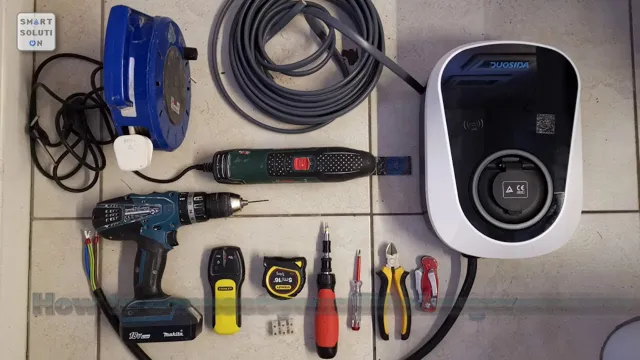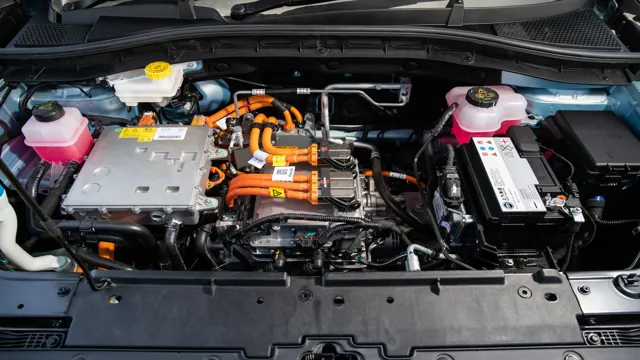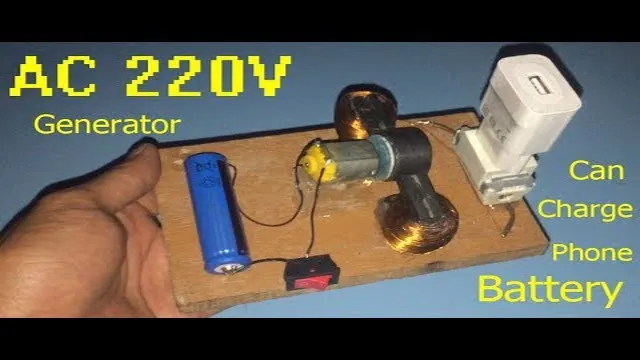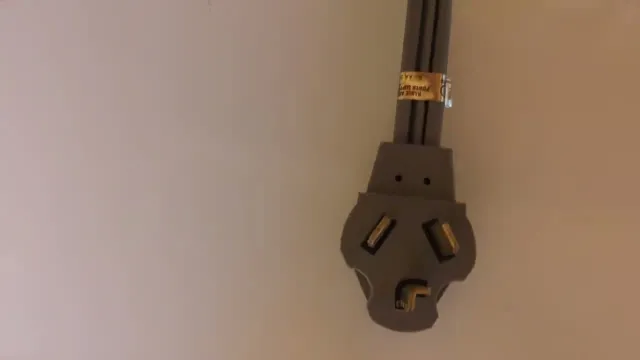Empower Your Electric Ride: Learn How to Safely Install Your Own EV Charger at Home
Have you recently purchased an electric vehicle and wish to install a home charging station? Look no further because we’ve got you covered! Charging your EV at home is an efficient, convenient, and cost-effective way to ensure that your vehicle is always ready to hit the road. With the rise in the number of electric vehicles, there has been a significant increase in the demand for DIY EV charger installation guides. In this blog post, we will provide you with a comprehensive guide on the installation of an EV charger at home.
We’ll cover everything from choosing the right charger to the installation process itself. So, let’s dive in and get your EV charging station set up in no time!
Benefits of DIY Installation
If you’re considering installing your own EV charger, there are several benefits to taking the DIY approach. First and foremost is cost savings. Professional installation can be expensive, but doing it yourself can save you a significant amount of money.
Additionally, it can give you a sense of accomplishment and ownership over the project. You’ll have the satisfaction of knowing that you installed your own charger and can rely on yourself for future maintenance or repairs. Plus, doing it yourself means you can customize the installation to your specific needs and preferences.
However, it is important to note that DIY installation may not be suitable for everyone. If you’re not confident in your skills or don’t have the necessary tools, it may be best to leave it to the professionals. Additionally, some manufacturers’ warranties may require professional installation in order to be valid.
Therefore, before starting any installation, it’s important to carefully consider your abilities and the warranty requirements to determine if DIY is the right choice for you. But for those who feel comfortable with the task, installing your own EV charger can be a rewarding and cost-effective approach.
Cost Savings
One of the biggest benefits of DIY installation is the significant cost savings. When you hire a professional to install something in your home, you are not only paying for their expertise, but also for the labor costs that come with their service. However, when you take on the task of installing something yourself, you eliminate these labor costs and only have to pay for the materials.
This can add up to a substantial amount of money saved over time. Additionally, by doing the installation yourself, you may be able to find deals on materials or repurpose items you already own, further reducing costs. Overall, DIY installation is a great way to save money while still being able to add value and upgrades to your home.
So why not give it a try and see the savings for yourself?
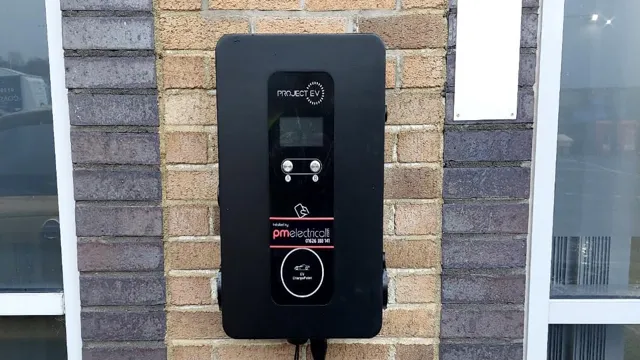
Flexibility and Control
DIY Installation One major benefit of DIY installation is the flexibility and control it provides homeowners. Unlike professional installation services, DIY installation allows homeowners to schedule their installation at their own convenience, without having to wait for an appointment or pay for a costly installation fee. Additionally, homeowners have full control over the installation process, from choosing the location of the equipment to executing the installation itself.
This level of control not only ensures a more personalized and customized installation experience but also saves homeowners money in the long run. With the right tools and resources, DIY installation can be a feasible option for many homeowners, providing flexibility and control over their home security systems.
Factors to Consider Before Installation
Yes, you can install your own EV charger, but there are some factors to consider before doing so. First and foremost, ensure that your home’s electrical system can handle the load of the charger. An electrician can help you determine if any upgrades or modifications are necessary.
You should also research and purchase a charger that is compatible with your vehicle and meets your charging needs. Additionally, consider the location of the charger and the accessibility for your vehicle. Lastly, check with your local building codes and regulations to ensure that you are following all necessary guidelines for the installation.
While installing your own EV charger may seem daunting, with careful planning and following safety guidelines, it is achievable for most homeowners.
Electricity Capacity
When it comes to installing an electricity capacity, there are several factors to consider before making the investment. Firstly, it’s important to calculate your current and future energy needs and ensure that the capacity you choose can accommodate them. Additionally, you’ll want to consider the cost and timeline of the installation process, as well as any maintenance or repair expenses that may arise.
It’s also essential to select an electricity capacity that aligns with your environmental values, and that uses sustainable and renewable energy sources whenever possible. Ultimately, taking the time to carefully assess your electricity capacity needs and evaluate the available options can save you time, money, and resources in the long run while providing you with a reliable source of power that meets your needs.
Available Parking Space
When considering the installation of an available parking space, there are a few key factors to keep in mind. Firstly, you need to consider the size of the space you need and how many vehicles you want to park. You also need to consider the surface of the ground, as this can affect the longevity and safety of the space.
The level of security you require is also an important consideration. This can range from simple barriers to more sophisticated systems such as automated gates or security cameras. Finally, the location of the parking space is another factor to consider.
Will it be tucked away out of sight or located in a high-traffic area with plenty of visibility? By considering all of these factors before installation, you can ensure that your available parking space is functional, safe, and secure for all those who use it.
Local Regulations and Permits
When it comes to installing a new system or equipment, it’s essential to consider local regulations and permits. Each state or municipality has its own set of rules and regulations, particularly when it comes to the construction industry. Therefore, before making any moves, make sure to research and understand the local regulations, building codes, and permits that you’ll require to avoid running into legal or financial hassles down the road.
It’s critical to keep in mind that obtaining a permit takes time, effort, and resources. Still, failure to comply with the local regulations can lead to delays in your project or even worse, hefty fines and penalties. To avoid such situations and ensure a smooth installation process, consult with a professional who knows the ins and outs of the local regulations.
They can assist you in navigating the complex world of permits and regulations and keep your project on track. Overall, taking the time to understand the local regulations and permits will not only save you from legal woes down the road but will also guarantee that you are meeting all the safety standards and making the most out of your investment.
Tools and Materials Needed
Yes, you can install your own EV charger as long as you have the necessary tools and materials. The first thing you need is a charger that is compatible with your electric vehicle. You will also need a dedicated 240-volt circuit and outlet that you can plug the charger into.
This may require hiring a licensed electrician to install the necessary electrical infrastructure. Additionally, you will need basic tools such as a power drill, screwdrivers, wire cutters, and wire strippers. Read the installation instructions carefully before you begin and follow all safety guidelines.
Remember to turn off the power supply at the main breaker before working on the circuit or outlet. Installing your own EV charger can be a rewarding and cost-effective way to prepare for a cleaner, greener future.
EV Charger Unit
If you’re planning to install an EV charger unit at home, there are some basic tools and materials that you’ll need to have on hand to ensure a smooth and successful installation. First and foremost, you’ll need a charger unit that’s compatible with your electric vehicle make and model. Be sure to do your research and choose a reputable brand that offers both quality and affordability.
You’ll also need a voltage tester, wire stripper, conduit cutter, conduit bender, and a variety of electrical connectors and fasteners. Additionally, you may want to consider hiring a licensed electrician to help with the installation, especially if you’re not comfortable working with electrical wiring. Remember, safety should always come first when handling electrical equipment, so take your time and follow all manufacturer instructions and local building codes.
Overall, with the right tools and materials, installing an EV charger unit at home can be a rewarding and eco-friendly experience that allows you to recharge your electric vehicle in the comfort of your own garage or driveway.
Circuit Breaker
A circuit breaker is an essential component for any electrical system to ensure safety and prevent electrical fires. It operates by interrupting the flow of electricity when a fault or overload occurs. To install a circuit breaker, you will need a few tools and materials.
These include a circuit breaker panel, a circuit breaker tester, a voltage tester, wire strippers, screwdrivers, pliers, and a circuit breaker box cover plate. Make sure to turn off the power supply before starting any work and follow all safety precautions. It’s vital to choose the right size and type of circuit breaker for your electrical system to ensure proper protection.
Overall, installing a circuit breaker takes some basic tools and knowledge but is essential for the safety and protection of your electrical system.
Wire Cutters and Strippers
When it comes to working with electrical wiring, it’s important to have the right tools and materials on hand. One of the most essential pieces of equipment is a wire cutter and stripper. These tools are used to cut and strip wires, allowing you to connect and disconnect them as needed.
The wire cutter is used to cleanly cut the wire to the desired length, while the stripper is used to remove the insulation from the wire. This is important because it makes it possible to connect the wires together without creating a short circuit. When choosing wire cutters and strippers, it’s important to select high-quality tools that are designed for the job at hand.
Look for tools that are comfortable to use, have sharp blades, and are made from durable materials. With the right tools and materials, working with electrical wiring can be safe and easy.
Voltage Tester
If you’re planning to do electrical work in your home, a voltage tester is an essential tool to have in your toolkit. This device helps you detect whether a circuit has electrical current flowing through it or not. To get started, you will need a voltage tester, safety gloves, and safety goggles.
The voltage tester comes in two types: a non-contact tester and a contact tester. The non-contact voltage tester is ideal for locating power sources without requiring direct contact with the electrical wires. A contact tester, on the other hand, requires contact with the wires to determine if there is electricity flowing.
Don’t forget to wear safety gloves and protective goggles to avoid electric shock while working with electrical circuits. Ensure you handle the voltage tester properly and follow the instructions given by the manufacturer. With a voltage tester, you can work safely, confidently and prevent electrical shock or damage to your electrical systems.
Step-by-Step Guide to Installation
If you’re considering installing your own EV charger, the good news is that it is possible! With the right tools and some basic technical knowledge, you can easily install your own home charger for your electric car. Before you start the installation process, it’s important to understand the type of charger your car needs and the electrical requirements for your home. You’ll need to identify the power source and potential installation sites for the charger.
It’s also important to make sure you have the necessary permits and regulations in place, as well as ensuring the charger is installed correctly for safety reasons. It’s important to note that if you don’t feel confident in your abilities to install the charger yourself, it’s always better to hire a professional to do the job. With a little patience and the right guidance, you can easily install your own EV charger and enjoy the benefits of driving an electric vehicle.
So, can you install your own EV charger? Yes, you can! Just make sure you’re taking the proper precautions and doing your research before getting started.
Turn Off Electricity and Identify Breaker
Before you begin any electrical installation, it’s critical to turn off the power to the area where you’ll be working. This will help you avoid any mishaps and keep you safe while you work. Make sure to identify which breaker controls the area by checking your breaker panel.
Typically, breakers are labeled, but if they’re not, you’ll need to do a bit of trial and error to figure out which one is the right one. Start by turning off the main circuit breaker, and then work your way through the other breakers one-by-one until you find the one that controls your work area. Once you’ve identified the right breaker, switch it off.
It’s essential to remember not to rely on just shutting off the light switch or unplugging any appliances, as these may not completely eliminate the current. Taking these steps will ensure that you can safely move forward with your installation. Remember, safety should always come first.
Run Electrical Wires and Attach Charger
If you’re planning to install an electric vehicle (EV) charger at home, one of the essential steps is running electrical wires and attaching the charger. Start by assessing your electrical capacity and checking your local codes and regulations. You may need to upgrade your electrical panel and obtain permits before proceeding.
Once you’ve confirmed the necessary requirements, determine the safest and most efficient route for the wires, avoiding areas with heavy foot traffic or water exposure. Then, carefully install the wires, ensuring they’re properly insulated, labeled, and connected to an appropriate circuit breaker. Finally, attach the charger, following the manufacturer’s instructions, and test it to ensure proper functioning before use.
Remember to work with a licensed electrician for this installation to ensure your safety and the optimal performance of your EV charger.
Connect Charger to Electrical Panel
If you’re looking to connect a charger to your electrical panel, it can seem like a daunting task at first. But with the right tools and a bit of know-how, it’s actually a fairly simple process. The first step is to turn off the power to the panel to avoid any accidents.
Once this is done, you can connect the charger to the panel using the proper wiring. Make sure to use wires that are rated for the proper amperage and follow any guidelines or instructions that come with your charger. It’s also a good idea to double-check all connections to ensure they are secure before turning the power back on.
With these steps completed, you should be ready to charge your devices safely and easily. Remember, always prioritize safety and double-check your work to avoid any potential issues down the line.
Test Charger and Restart Electricity
If you’re thinking about installing an electric vehicle (EV) charging station at home, it’s important to ensure that your home’s electrical system is capable of handling the increased demand. One step in this process is to test the charger and restart your electricity. This can be done by turning off the power at the circuit breaker and plugging in the charging station.
Then, turn the power back on and monitor the charging station for any issues. It’s important to consult with a licensed electrician to ensure that your home’s electrical system can handle the added demand and that the EV charger is installed correctly. By taking these steps, you can ensure that your EV charging station is installed safely and effectively, allowing you to enjoy the benefits of electric transportation without any worries.
Important Safety Tips
If you’re wondering whether you can install your own EV charger at home, the answer is yes, but there are some important safety tips you should keep in mind. First and foremost, always turn off the power supply at the breaker before attempting any electrical work. Be sure to follow instructions carefully and double-check your work, as any mistakes could be dangerous or cause damage to your vehicle.
Additionally, make sure to use the correct gauge of wire and always use a grounded outlet. It’s also important to have a licensed electrician inspect any electrical work you do to ensure it meets building codes and is safe for use. By taking these precautions, you can safely and successfully install your own EV charger at home.
Consult with a Professional if Unsure
When it comes to our safety, it’s always better to err on the side of caution. If you’re unsure about the safety of something, it’s always best to consult with a professional. They have the expertise to advise you on whether a particular activity or item is safe or not.
For instance, if you’re thinking about getting a new stove for your kitchen, but you’re not sure if it’s safe to install it yourself, it’s better to get a professional to do it for you. Additionally, it’s always important to read the safety instructions that come with any product or activity, whether it’s a new appliance or a DIY project. These instructions are there to keep you safe, so it’s crucial that you take them seriously.
Remember, safety should always be your top priority, so don’t hesitate to reach out if you need help.
Wear Protective Clothing and Equipment
When it comes to ensuring workplace safety, wearing protective clothing and equipment plays a crucial role. No matter what industry you work in, your employer must prioritize your safety by providing you with appropriate gear. This equipment can range from helmets, gloves, goggles, respirators, and even full-body suits.
Proper safety gear is designed to minimize exposure to harmful substances and protect you from falls, electrical hazards, and other potential dangers. Not using such protective equipment can lead to serious injury or even death. It’s important to understand which protective gear you need and to ensure it’s correctly fitted and in good condition, as poorly fitted or damaged gear can be just as hazardous as no gear at all.
Remember to wear your protective gear every time you’re on the job – it could save your life!
Turn off Electricity at Main Panel During Installation
When it comes to installing or working on electrical appliances or systems, safety should always be the top priority. One important safety tip to keep in mind is to turn off the electricity at the main panel before beginning any work. This will prevent any accidents or injury caused by electric shock.
It’s important to remember that even if the power is turned off to a specific outlet or room, there may still be live wires and electrical currents within the system. It’s always better to be safe than sorry, so double-checking that the power is turned off at the main panel is crucial. By taking this extra step, you can ensure both your own safety and the safety of others around you.
Conclusion
In conclusion, the question of whether you can install your own EV charger is a bit like asking if you can bake your own wedding cake. Technically, yes, it’s possible, but it’s definitely not recommended unless you have the knowledge, experience, and equipment to do it safely and effectively. So, unless you’re an electrician with a passion for DIY projects, it’s probably best to leave the installation of your EV charger to the professionals.
After all, when it comes to something as important as powering up your electric vehicle, it’s always better to be safe than sorry.”
FAQs
What are the requirements for installing an EV charger at home?
The requirements for installing an EV charger at home depend on the type of charger you’re installing. However, most commonly, you’ll need a dedicated electrical circuit, proper wiring, and a compatible EV charging station.
Can I install my own EV charger?
Yes, it’s possible to install your own EV charger if you have the necessary skills and knowledge. However, it’s recommended to hire a professional electrician or an EV installation company to ensure safety and accuracy.
How much does it cost to install an EV charger at home?
The cost of installing an EV charger at home varies depending on several factors, such as the type of charger, installation location, and labor costs. Typically, installations can range from a few hundred dollars to several thousand dollars.
Do I need a permit to install an EV charger at home?
Yes, you may need a permit from your local building department or utility company before installing an EV charger at home. It’s important to check with your local authorities to ensure that you follow all regulations and obtain the necessary permits.

